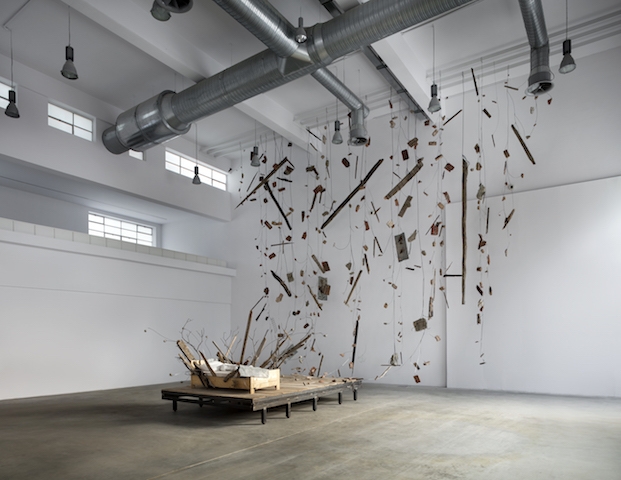In a small town in the depths of the Kosovan countryside lies the dilapidated shell of a former cultural centre. Many of its walls have crumbled, its roof has collapsed, its floor is ankle deep with rubbish. It’s not that remarkable a place, and Runik isn’t that remarkable a town, but it’s where Petrit Halilaj grew up. The cultural centre once thrummed with life, but all that’s left is the crap that remains when things have been forgotten, when the world around you has moved on. And now, chunks of it are in an art gallery in Turin.
The big metaphor at the heart of Halilaj’s work at the Fondazione Merz – the final part in a trilogy of shows that started with a performance in Runik’s dilapidated cultural centre, became an exhibition at the Zentrum Paul Klee and is now an installation – isn’t subtle. It’s a lobbed breezeblock of a message: his childhood cultural centre in his rural hometown is in ruins, so his culture itself is in ruins. That culture embodies a sense of self, identity and purpose: and it’s all been left bereft and derelict. Now Halilaj is trying to spark, or ‘shkrepëtima’, it back to life.
Scattered around the space of the Fondazione Merz are the remnants of that cultural centre: chunks of timber, masonry and bricks hang suspended from the ceiling, draping towards a bed covered in wood and clay recreations of Neolithic objects, copies of artefacts found in and around Runik. It’s as if Halilaj has frozen time just as a tornado ripped the building from its foundations, dragging the debris up into the sky in a sort of arte povera cyclone. High platforms, wooden structures like guard towers, line the rest of the space. Toy rifles and blackboards hang from red curtains suspended from the platforms. These are the objects of the town’s demise, and the symbols of what was lost. Education and tradition blighted by neglect.
But angelic winged creatures, floating up by the ceiling, hint that these objects could also be the symbols of rebirth. The problem is, it’s pretty obvious that you’re surrounded by props from a performance rather than finished pieces. It ends up feeling like the detritus of art rather than the work itself, objects that once meant something but now just represent those ideas. It even looks like a stage set, begging dramatically to be brought alive by actual action. Drawings in the adjoining room feel like an afterthought, and, down in the basement, a film documents the performance at the heart of all this, but that also doesn’t feel that fulfilling, because it’s not the performance, it’s not the art, it’s a document of it. And that’s only half of a story.
Despite those shortcomings, in this messy builders’ yard of an exhibition, Halilaj is trying to cobble together a sense of identity out of the ashes of a cultural bonfire, trying to make something new out of the ruins. It’s reconstruction out of literal destruction, or at the very least dereliction. This is bigger than the objects in front of you, this is Halilaj dragging eyes and attention back to his hometown, and his hometown’s cultural corpse back to life through his art, and there might just be a pulse there.
Petrit Halilaj: Shkrepëtima at Fondazione Merz, Turin, 29 October – 3 February
From the January & February 2019 issue of ArtReview
